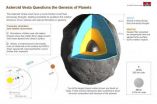(Press-News.org) New research has identified a potential cause of and a better diagnostic method for preeclampsia, one of the most deadly and poorly understood pregnancy-related conditions in the world. The international team, led by researchers at Nationwide Children's Hospital, discovered that the disease may result from a collection of protein mishaps like those associated with Alzheimer's disease. Their findings, released today by Science Translational Medicine, have already led to an affordable, fast and accurate urine test that could revolutionize the diagnosis of preeclampsia in resource-poor nations.
"Preeclampsia is a very important health problem for women around the world, but for many years no one has understood why or how it happens," said Irina A. Buhimschi, MD, director of the Center for Perinatal Research in The Research Institute at Nationwide Children's and first author on the paper. "We were studying the urine of pregnant women with preeclampsia and noticed these improperly folded proteins, and that was the 'Eureka!' moment. It meant that preeclampsia could be similar to other protein misfolding diseases, such as Alzheimer's and mad cow disease."
Dr. Buhimschi's team is the first to characterize the range of misfolded proteins found in the urine of pregnant women with preeclampsia.
Preeclampsia is the leading cause of preterm delivery in industrialized nations and accounts for up to 75,000 maternal deaths worldwide each year. It is characterized by protein in the urine and often-asymptomatic high blood pressure of no clear origin. When left untreated, the condition can progress to cause seizures, stroke, liver failure and death. Preeclampsia typically appears after the 20th week of pregnancy and only resolves upon delivery of the baby.
Dr. Buhimschi found that, in women with preeclampsia, the placenta was clogged with similar misfolded protein material to that found in the brains of people with Alzheimer's. To carry out their functions properly, proteins must fold themselves into precise three-dimensional structures. But misfolded proteins, which fail to morph into their intended shape, are unable to function correctly. These and other proteins try to travel to and from the mother and baby on what is essentially a busy highway, Dr. Buhimschi explained, but the misfolded proteins build up in the mother's body and in the placenta and cause a traffic jam.
To better understand the presence and importance of these proteins in the urine of pregnant women with preeclampsia, the team used a dye called Congo Red, which was known to bind proteins such as amyloid based on previous research done with other protein misfolding conditions. When this dye was used to test the urine of pregnant women, researchers found that it helped identify both the presence and future severity of preeclampsia.
The identified misfolded proteins include the amyloid precursor protein and enzymes and beta-amyloid, which are all associated with Alzheimer's. Additional proteins found that often misfold include ceruloplasmin, immunoglobulin- free light chains and SERPINA1, which build up in toxic quantities in protein conformational disorders. Interferon-inducible protein 6-16 (IFI 6-16), a protein not previously known to be associated with other misfolding diseases but that was uniquely found misfolded in the urine of women with preeclampsia, is known to help prevent cell death and, in breast cancer cells, is responsible for resistance to treatment. The team used computer modeling to predict IFI 6-16's involvement in preeclampsia aggregates and is continuing research to determine the mechanisms behind this and other proteins' involvement in preeclampsia.
The studies resulting in this publication began seven years ago and have already led to a paper-based Congo Red Dot urine test for preeclampsia that won the international Grand Challenges for Development award, sponsored in part by the United States Agency for International Development. The project is now funded by a transition-to-scale grant from the Saving Lives at Birth consortium to determine whether the test improves preeclampsia diagnosis and reduces morbidity and mortality in resource-poor nations.
"In a way, we put the cart before the horse, getting the test in gear before we were able to formally publish all of the science behind it," Dr. Buhimschi said. "It was just a great opportunity to really help people with a simple, cheap, non-invasive and very accurate test."
The paper test currently being piloted is a more user-friendly version than the one in this publication, Dr. Buhimschi said, but it is based on the study's results regarding the ability of Congo Red dye to bind with the misfolded proteins in women's urine. "The test can help identify preeclampsia and predict its severity even before clinical symptoms appear," she explained. "These proteins aren't excreted in the urine of women who do not develop preeclampsia."
While pilot testing continues around the world and at The Ohio State University Wexner Medical Center, Dr. Buhimschi and her collaborators are working to better understand the profile of misfolded proteins present in women with preeclampsia.
"In most protein conformational disorders, there is a particular protein that is the key culprit," said Dr. Buhimschi, who also is a tenured professor at The Ohio State University College of Medicine. "If we can figure out which protein is the most critical actor in preeclampsia, we could potentially use drugs that target protein misassembly for that particular protein. This would allow us to treat or even prevent preeclampsia symptoms in women who test positive on the Congo Red Dot test."
Understanding the range of mechanisms behind the pathophysiology of preeclampsia will be even more crucial to developing an effective treatment.
"The story is not over," Dr. Buhimschi said. "Preeclampsia may be more than one disease. Particular types may be associated with certain subtypes of protein collections. We want to figure out exactly how each misfolded protein collection affects pregnant women and what we can do about it."
INFORMATION:
Citation
Buhimschi IA, Nayeri UA, Zhao G, Shook LL, Pensalfini A, Fuani EF, Bernstein IM, Glabe CG, Buhimschi CS. Protein misfolding, congophilia, oligomerization, and defective amyloid processing in preeclampsia. Science Translational Medicine. 16 July 2014, 6(245).
Preeclampsia may share cause with disorders such as Alzheimer's
2014-07-16
ELSE PRESS RELEASES FROM THIS DATE:
Walking on all fours is not backward evolution, study shows
2014-07-16
VIDEO:
This video is a sample of UTS walking patterns.
Click here for more information.
AUSTIN, Texas -- Contradicting earlier claims, "The Family That Walks on All Fours," a group of quadrupedal humans made famous by a 2006 BBC documentary, have simply adapted to their inability to walk upright and do not represent an example of backward evolution, according to new research by Liza Shapiro, an anthropologist at The University of Texas at Austin.
Five siblings in the family, ...
New study links dredging to diseased corals
2014-07-16
In a world-first study published today, researchers say dredging activity near coral reefs can increase the frequency of diseases affecting corals.
"At dredging sites, we found more than twice as much coral disease than at our control sites," says the lead author of the study, Joe Pollock, a PhD candidate from the ARC Centre of Excellence for Coral Reef Studies (Coral CoE) at James Cook University (JCU) and the Australian Institute of Marine Science (AIMS).
"Corals require both light and food to survive," Pollock explains. "And unfortunately, dredging impacts corals ...
Tooth plaque provides unique insights into our prehistoric ancestors' diet
2014-07-16
This news release is available in French. This news release is available in French. This news release is available in French.
An international team of researchers has found new evidence that our prehistoric ancestors had a detailed understanding of plants long before the development of agriculture.
By extracting chemical compounds and microfossils from dental calculus (calcified dental plaque) from ancient teeth, the researchers were able to provide an entirely new perspective on our ancestors' diets. Their research suggests that purple nut sedge (Cyperus ...
Tooth plaque provides insight into our prehistoric ancestors' diet
2014-07-16
A new study may provide evidence that our prehistoric ancestors understood plant consumption and processing long before the development of agriculture, according to a study published July 16, 2014 in the open-access journal PLOS ONE by Stephen Buckley from University of York and colleagues.
Evidence of plant consumption before the adoption of agriculture is difficult to find; such evidence is meaningful for understanding how much prehistoric people knew about the ecology and potential therapeutic properties of plants. Scientists in this study extracted and analyzed chemical ...
The 'obesity paradox': Cardiovascular mortality lowest among overweight patients
2014-07-16
Rochester, MN, July 16, 2014 – High body mass index (BMI) is associated with multiple cardiovascular diseases. However, emerging data suggest that there is an "obesity paradox," that being overweight may actually protect patients from cardiovascular mortality. Investigators have now confirmed that the risk of total mortality, cardiovascular mortality, and myocardial infarction is highest among underweight patients, while cardiovascular mortality is lowest among overweight patients, according to two reports published today in Mayo Clinic Proceedings.
Currently more than ...
Brain of world's first known predators discovered
2014-07-16
An international team of paleontologists has identified the exquisitely preserved brain in the fossil of one of the world's first known predators that lived in the Lower Cambrian, about 520 million years ago. The discovery revealed a brain that is surprisingly simple and less complex than those known from fossils of some of the animal's prey.
The find for the first time identifies the fossilized brain of what are considered the top predators of their time, a group of animals known as anomalocaridids, which translates to "abnormal shrimp." Long extinct, these fierce-looking ...
One injection stops diabetes in its tracks
2014-07-16
VIDEO:
Salk scientists explain the implications of their latest finding and how the treatment reverses symptoms of type 2 diabetes in mice without side effects.
Click here for more information.
LA JOLLA—In mice with diet-induced diabetes—the equivalent of type 2 diabetes in humans—a single injection of the protein FGF1 is enough to restore blood sugar levels to a healthy range for more than two days. The discovery by Salk scientists, published today in the journal Nature, could ...
Study: Climate-cooling arctic lakes soak up greenhouse gases
2014-07-16
New University of Alaska Fairbanks research indicates that arctic thermokarst lakes stabilize climate change by storing more greenhouse gases than they emit into the atmosphere.
Countering a widely-held view that thawing permafrost accelerates atmospheric warming, a study published this week in the scientific journal Nature suggests arctic thermokarst lakes are 'net climate coolers' when observed over longer, millennial, time scales.
"Until now, we've only thought of thermokarst lakes as positive contributors to climate warming," says lead researcher Katey Walter Anthony, ...
Scientists find way to trap, kill malaria parasite
2014-07-16
Scientists may be able to entomb the malaria parasite in a prison of its own making, researchers at Washington University School of Medicine in St. Louis report July 16 in Nature.
As it invades a red blood cell, the malaria parasite takes part of the host cell's membrane to build a protective compartment. To grow properly, steal nourishment and dump waste, the parasite then starts a series of major renovations that transform the red blood cell into a suitable home.
But the new research reveals the proteins that make these renovations must pass through a single pore ...
Asteroid Vesta to reshape theories of planet formation
2014-07-16
EPFL researchers have a better understanding of the asteroid Vesta and its internal structure, thanks to numerical simulations and data from the space mission Dawn. Their findings, published today in Nature, question contemporary models of rocky planet formation, including that of Earth.
With its 500 km diameter, the asteroid Vesta is one of the largest known planet embryos. It came into existence at the same time as the Solar System. Spurring scientific interest, NASA sent the Dawn spacecraft into Vesta's orbit for one year between July 2011 and July 2012.
Data gathered ...






